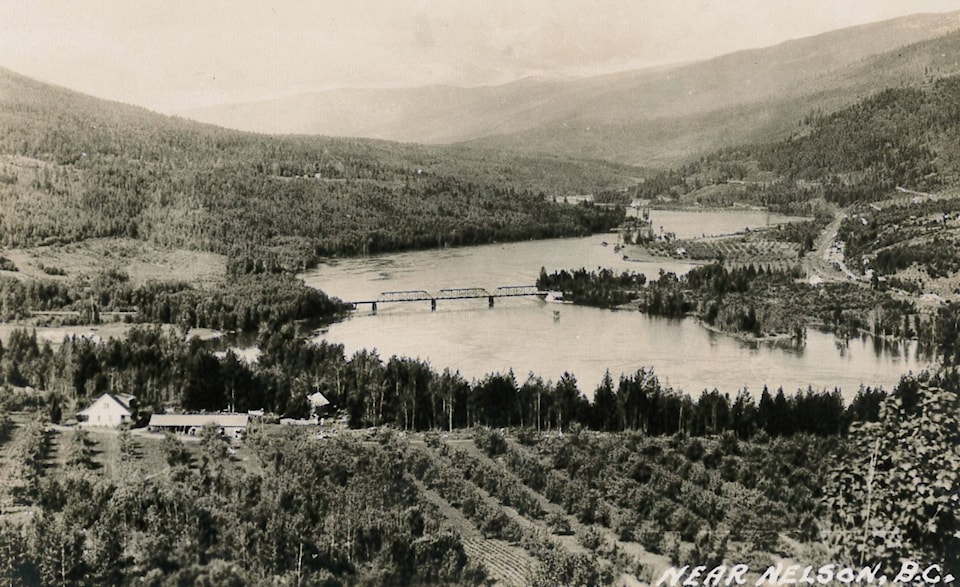One hundred ninety-second in an alphabetical series on West Kootenay place names
Taghum is one of the handful of West Kootenay place names that comes from Chinook Jargon, a pidgin trade language used in BC and the western United States in the 19th century.
It means six. But six what? Some sources suggest six miles from Nelson — but it’s actually less than five. Others say it was for the distance to the Nelson wharf or from Nelson to Bonnington Falls.
In any case, the prime suspect for the name’s choosing is John C. Bell, Nelson’s mayor in 1925 and half of the lumbering partnership of Lambert and Bell. In 1895, Bell pre-empted land at Sitkum Creek — the Chinook word for middle or half. In 1905, he and Lambert erected a mill in the Slocan Valley at a spot then known as Watson Siding. The following year the CPR changed the name on its timetable to Lebahdo — the Chinook word for shingle, which was probably one of the mill’s products.
Bell and Lambert soon moved their mill to Sproule Creek, and the location became known as Taghum. However, Bell doesn’t appear to have taken credit for any of these names and nothing in his biography explains a fondness for Chinook jargon.
If Bell didn’t come up with Taghum, perhaps it was prospector Mickey Monaghan, who obtained a Crown grant for Lot 2355 in 1901. The earliest mention of Taghum is in the Nelson Daily Canadian of June 26, 1906 regarding his mining claim in the general vicinity: “F.T. Morrison, as agent for M.C. Monaghan, recorded the Taghum, and as agent for J. McGarvey, the Moose, both situated nine miles west of Nelson, about two miles north of Kootenay river, located on June 12.”
Taghum at its current location was on the CPR timetable as of September 1907.
Before that, the area had several other names: Davenport, Woodsville, and Kootenay Crossing — all previously covered in this series — plus Williams Siding. Davenport and Woodsville were a little west of the present Taghum beach on the south side of the Kootenay River, Williams Siding was on the north side, and Kootenay Crossing was where the present train bridge is.
The latter name was still in use as of July 4, 1903 when the Nelson Daily News wrote: “The steel for three new spans of the bridge at Kootenay Crossing arrived this week, and will be held here till the river subsides enough for work to be resumed at the crossing.”
But when the post office opened on Feb. 1, 1906 it was known as Williams Siding, after founding postmaster James Nicholas Williams (1861-1931). (Bell and Lambert each subsequently took turns at postmaster, as did Joshua Marsden, who has a road named after him. A postcard with a Williams Siding cancel sold online for $116 in 2012.)
The late Dave Norcross wrote in the Daily News of April 23, 1979 that Jim Williams was “foreman at the Poorman mine who had established a family home on land below the [old] Taghum bridge and between the river and the railway.”
Williams was from Cornwall, England and immigrated to Canada with his wife and Sarah and six children sometime in 1892. However, he resigned as postmaster in 1907 and appears to have left his namesake community — he eventually returned to Cornwall. Perhaps for that reason residents thought another name change was in order.
The Daily News of Feb. 3, 1912 reported: “A meeting of the residents of Taghum and Williams’ Siding was held at the school house on Tuesday evening … The question of changing the railway name of Taghum and the post office name of Williams’ Siding for a more suitable name was discussed. A committee was appointed at a previous meeting to submit a list of suitable names and the public was also invited to assist. A large list of suitable names was submitted. Finally, they were reduced down to two, Sproule and Shrewsbury. A ballot was taken and Shrewsbury was selected. The secretary was instructed to write to A.S. Goodeve, the member for Kootenay, to induce the postal authorities to change the post office name to Shrewsbury, and on a favorable reply the committee will wait upon the CPR with a similar request.”
There’s a Shrewsbury in England. Sproule was after the creek, which we’ll look at in more detail later in this series. It’s not clear why the residents’ request wasn’t acted upon, but the post office remained Williams Siding until 1924, when it was renamed Taghum. It closed in 1970.
Today Taghum is on both sides of the Kootenay River: the community hall and store are on the north side, while the public beach is on the south side. The latter area was once known as Granite Siding, which we’ve previously looked at. There’s still a Granite Siding Road, across the street from the beach.
Taghum Hill — the steep section of Granite Road — used to be a common local name, but it has faded from use since the present Taghum bridge opened in 1979.
